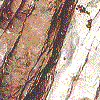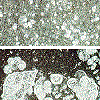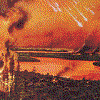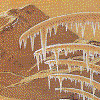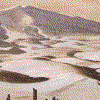On 1978, Walter Alvarez, a geologist at the University of California, Berkeley, collected some samples of a thin layer of gray clay near the town of Gubbio. This layer seemed to indicate the end of the Cretaceous period and the beginning of the Tertiary. A section of limestone from the Cretaceous is embedded with fossils of foraminifera, a microscopic planctonic species, while the Tertiary sample contains far fewer.
Walter's father, Nobel laureate physicist Luis Alvarez, suggested he measure the amount of iridium in the clay layer. Iridium is common in comets and meteorites, but exceedingly rare un Earth's crust. The clay at the K-T limit contained 30 times more iridium than the gradual deposition of micrometeorite dust coul account for. They suggested that a large meteorite, roughly 8 km in diameter, had smacked into Earth 65 million years ago, carrying with it some 200,000 tons of iridium.
But.. where was the hole?
The Mexican national petroleum company, Pemex, had discovered in the 1950s
an unusual layer of broken while drilling the northern coast of Mexico's
Yucatan Peninsula. A magnetic survey revealed later a large circular structure
centered near the town of Chicxulub. In 1968 and 1972, two geologist suggested
the region represented a large buried crater. In 1991, the truly nature
of the site was stated without any doubt.
Chronology of the catastrophe:
- Time zero: As the object cannonballed through Earth's atmosphere, it blew a hole in the air. Reaching the ground about three secons later, released the equivalent to10 trillion megatons of TNT.
- First hour: 100-foot-high walls of water flooded coastal planes. Earthquakes shaked the region. Minutes after the impact, billions of tons of debris blasted into space and then reentered Earth's atmosphere reheating and ablating at an altitude above 60 km. The sky probably turned to a brilliant red sheet of glowing lava. Large animals are broiled. Only animals with natural shelters might still survive.
- First six months: Soot from charred debris block out the Sun, plunging the world into darkness for as long as a year.
- First decade: Sulphur ejected into the stratosphere and slowly converted into sulphuric acid, a highly efficient Sun blocker, may have prolonged the blackout for as long as a decade. The lights turned out, phytoplankton stops reproducing and the ocean ecosystem collapses. Temperatures plummet, creating a micro Ice Age.
- And beyond: Carbon dioxide in the atmosphere warms the planet for 50 or 100 years, reaching a much hotter than normal peak.
